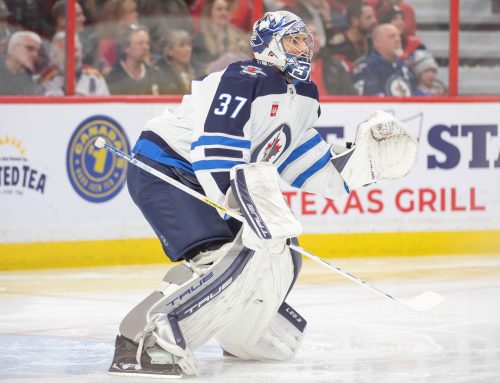Frozen Tool Forensics: Evaluating Those at the 2023-24 Breakout Threshold
Chris Kane
2023-08-04
Now that August is officially here we are going to be transitioning from our roundup related articles (like the MVP and playoff series') to some more specifically forward looking content. This week we are going to return to the idea of potential breakout players. Historically this column had reviewed the 4th year breakout candidates, but after some new work on breakout thresholds more specifically associated with games played numbers that Dobber posted last year, I adjusted the focus of the article to be in alignment with that.
The full article was posted on June 30th, 2022 and is a good read so definitely go check it out. The brief summary is that there tends to be a game count by which players start to break out. In this case breakout is defined as a 25 percent year-over-year increase. What they found is that average size forwards need about 200 games, and D plus exceptionally small, or larger forwards need about 400 games. Please go check it out for more details, but one section in particular caught my attention.
"It’s always a great indicator if you see that a player finishes the previous season with 230 or 240 career games and he just enjoyed a very strong second half. When you see that, then feel confident in a potential breakout for the year ahead."
That got me excited because here are a couple of variables that we can actively filter and sort for. With the right table or reports we can pull this information together and get a list of players who meet this criteria. According to this research it should be a list of players poised to do good things next year. The article also makes clear that these are all generalities, and there are definitely exceptions, but it made me very interested to see who might be on this list.
So how to pull together this data? Well we already know that we can run custom reports for the regular season (I am using Big Board), so if we pick a midpoint date (in this case I used Jan 9th) we can get point paces for players prior to and after that date. Looking at the difference there we can get a list of players who had a stronger second half than first half. There isn't a direct report for career games played, but with a little creative filtering on some longer term reports it can work.
Once I exported the reports with the data I needed I combined them for a custom table for filtering. After applying the games played and point pace criteria we get a list of six names.
| Name | Pos | 23-24 Team | Career GP | Second Half 82GP Pace | First Half 82GP Pace | Δ in Splits |
| SAMMY BLAIS | L | STL | 204 | 46 | 12 | 34 |
| KIRBY DACH | C | MTL | 210 | 64 | 48 | 16 |
| EETU LUOSTARINEN | L | FLA | 212 | 48 | 38 | 10 |
| MICHAEL RASMUSSEN | L | DET | 238 | 49 | 39 | 10 |
| TIM STUTZLE | C | OTT | 210 | 97 | 89 | 8 |
| JACK HUGHES | C | N.J | 244 | 108 | 100 | 8 |
This is certainly an intriguing list. Some of these players already saw quite a bit of success in 22-23 so might not be prime candidates for a second breakout, but we will get to that in a minute.
What we really want to know though is what we might be able to expect from these players in the future. If we assume that this list has a higher probability of hitting that breakout status than your typical player that means we are thinking these players will be more likely to put up at least 25 percent more points in 23-24 than they did in 22-23. That means we need to add some more point pace data to our table.
| Name | Pos | 23-24 Team | Career GP | 22-23 Second Half 82GP Pace | 22-23 First Half 82GP Pace | Δ in Splits | 22-23 Full Season Pace | Projected 23-24 Pace |
| SAMMY BLAIS | L | STL | 204 | 46 | 12 | 34 | 29 | 36 |
| KIRBY DACH | C | MTL | 210 | 64 | 48 | 16 | 54 | 68 |
| EETU LUOSTARINEN | L | FLA | 212 | 48 | 38 | 10 | 43 | 54 |
| MICHAEL RASMUSSEN | L | DET | 238 | 49 | 39 | 10 | 42 | 53 |
| TIM STUTZLE | C | OTT | 210 | 97 | 89 | 8 | 95 | 119 |
| JACK HUGHES | C | N.J | 244 | 108 | 100 | 8 | 104 | 130 |
Let's dig in.
Even with the potential of a 25 percent increase in point production it isn't clear that the entire list will be fantasy relevant. I am talking most specifically about Michael Rasmussen, Eetu Luostarinen, and Sammy Blais.
Rasmussen's 42 point pace was in the context of some looks alongside Dylan Larkin on a top line, or some combination of Andrew Copp, David Perron, and Robbi Fabbri during second line duty. With the additions of J.T. Compher, Alex Debrincat, Klim Costin, and Daniel Sprong those opportunities may be harder to come by. In addition he is also dealing with the fact that his five on five linemates ended the year with an inflated shooting percentage. Given a potential slight regression there and an increased challenge to maintain, let alone improve deployment (and maybe get some power-play time) it seems pretty unlikely he will end up breaking out.
Luostarinen is in much the same boat. He did get some opportunities in 22-23, and moving Anthony Duclair out certainly seemed to be a step in the right direction, but adding Evan Rodrigues dampened those expectations a bit. He did get some looks with both Matthew Tkachuk and Aleksander Barkov throughout the year though, and overall I do like his breakout chances better than Rasmussen's.
The simple season split doesn't really do Blais justice. He was traded to St. Louis on February 11th, a month after our split date, and got an instant change in deployment. With that he put up 20 points in 31 games or a 53 point pace. His shooting percentage was a bit high over that time period, and St. Louis went and added Kevin Hayes to increase competition so a couple of warning signs for sure. It might be the case where his 'breakout' points help him get closer to how he finished the season rather than improving on it.
Tim Stutzle and Jack Hughes also fall into a bit of the same category for me. With first time 95, and 104 point paces, both career highs by relatively significant margins, it seems pretty likely that their breakout has already arrived. Can they improve on those paces? Most definitely, but is it likely for example that Hughes will hit 130 points in 23-24? History says no just for the simple fact that almost no one does that. Same with Stutzle and his 119 point projection. Could they? Sure it is possible.
For our 22-23 review and projection we went in with no players who had put up over 90 points in the 21-22 season who were considered breakout candidates. We had one player – Robert Thomas with 87 and then three between 70 and 74, Tage Thompson, Roope Hintz, and Elias Pettersson. Of those four Thompson and Pettersson met their breakout threshold and improved their point paces to around 100 points (where Stutzle and Hughes are now). Hintz increased only slightly and Thomas (the closest point pace comparable) dropped off by a fair margin. The point is we don't have many good recent comparables or examples of a 90-100 point player 'breaking out' again.
That leaves Kirby Dach. A change in scene has clearly done him some good. Time with Nick Suzuki and Cole Caulfield would be ideal. Add that to his pedigree and there is some optimism he might hit that breakout threshold. If he doesn't meet it, linemates will likely be the cause. Either because he is centering a less potent second line, or because of a recent trend of injuries (both to him and Caulfield).
That is all for this week
Do your part to support organizations working to make hockey for everyone.





 BUF
BUF N.J
N.J PHI
PHI MIN
MIN FLA
FLA WPG
WPG VAN
VAN TOR
TOR CGY
CGY SEA
SEA